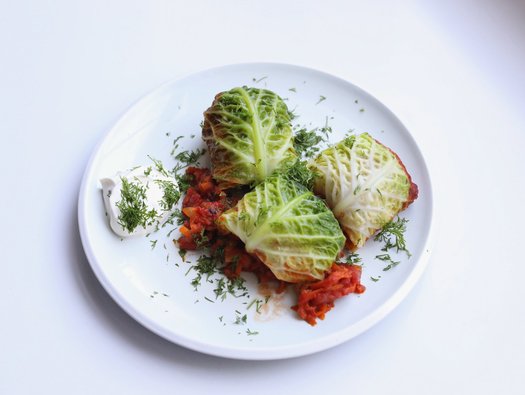Gołąbki

A delicious recipe that is low in salt but high in protein: perfect for those receiving dialysis.

A delicious recipe that is low in salt but high in protein: perfect for those receiving dialysis.
2 tablespoons vegetable oil
1 large onion, finely diced
1 carrot, coarsely grated
1 teaspoon caster sugar (optional)
1 tablespoon tomato purée
1 fresh (or dried) bay leaf
400g tin chopped tomatoes
1 large or 2 small heads of Savoy cabbage
250g beef mince
250g pork mince
160g white rice
140g mixed salad leaves
2 tablespoons olive oil
2 tablespoons lemon juice
150ml soured cream
Leaves from 20g fresh dill, chopped
Over a medium-high heat, heat the oil in a large, heavy frying pan or hob-safe casserole dish, then fry half the diced onion and the grated carrot for 10 minutes or until they are soft. Add the tomato purée and sugar (if using) and cook for another minute. Then add the tomatoes, 400ml cold water and the bay leaf and season with freshly ground black pepper. Simmer for 10 minutes. This will be your sauce.
Cook your rice, but for just half the amount of time it says on the packet. For example, if the packet says to cook it for 12 minutes, cook it for 6 minutes instead.
Bring a large pan of water to the boil and blanch the whole cabbage(s) for 5 minutes. Plunge into cold water, drain thoroughly and leave to cool and dry on kitchen paper.
In a large mixing bowl, mix the minced beef and pork with the parboiled rice, a few grinds of black pepper and the remaining diced onion – mix with your hands. Carefully tear off the leaves of the drained cabbage.
To make the parcels, spoon about 50g of filling into each cabbage leaf (you may find that you use less in smaller leaves). Wrap each one up and place them on top of the sauce in the frying pan or casserole, tucked up snugly and with the seam of each parcel underneath so they do not unravel.
Cook over a low heat on the hob for about 45 minutes (you want the sauce to be bubbling very gently) until the parcels are cooked through and piping hot. Serve with plenty of chopped dill and a spoonful of soured cream, with a green salad on the side, dressed in olive oil and lemon juice.
The rice is the main source of carbohydrate in this main meal and the value has been provided for those who have been trained in insulin adjustment.
This dish is low in potassium, despite the use of some high potassium ingredients, this is because the quantities have been kept low and, where possible, vegetables have been boiled and drained. If you are following a low potassium diet, be sure to keep to the quantities and serving sizes for this recipe. If you wish, you can enjoy this recipe without the tomato sauce, which will lower the potassium even further.
This recipe is also low in phosphate, however does contain some phosphate, therefore, if you have been prescribed a phosphate binder ensure you take them with this dish.
This dish is high in protein which makes it suitable for those advised to eat more protein. To lower the protein, consider reducing or omitting the meat and replace with caramelised onion.
Use brown rice instead of white, but instead of cooking it for half the stated cooking time, cook it for just 5 minutes less than the full amount stated. Gołąbki are traditionally made using beef and pork, but you can also use minced turkey or chicken meat if you prefer. However, they will be drier than Gołąbki made with beef and pork, so you’ll need to add extra oil to the filling so that they don’t dry out.
Swap the beef and pork for minced turkey or chicken meat. Be aware that it will be drier than Gołąbki made with beef and pork, so you’ll need to add extra oil to the filling so that they don’t dry out.
Keeping the cabbage parcels and sauce separate, these can be stored in the fridge for up to 3 days. To freeze, place the cabbage parcels (not touching each other) on a non-stick sheet and freeze - once frozen, keep them in a container in the freezer for up to 3 months, with the sauce in a separate container. Defrost (if they have been frozen) or bring to room temperature (if refrigerated) and cook as per step 6.
When you have chronic kidney disease (CKD), you may need to manage the levels of phosphate in your diet. Understanding the difference between natural phosphate and the phosphate found in processed foods will help you make the healthiest choices for you, with the support of your kidney dietitian.
You can enjoy a wide variety of delicious and healthy food when you are living with kidney disease. All Kidney Kitchen recipes are analysed and approved by kidney dietitians. Search through our kidney-friendly recipes or filter them by category below.
This quick and easy recipe can be eaten as a meal or used as an accompaniment to another dish in a lower quantity.
By giving us your email address, you're giving us permission to send you the latest news from Kidney Care UK. Further information about how we protect and use your personal data is available in our Privacy policy. If you would like to change the way we communicate with you at any time please email [email protected]. You can unsubscribe at any time by using the link at the bottom of every email we send.